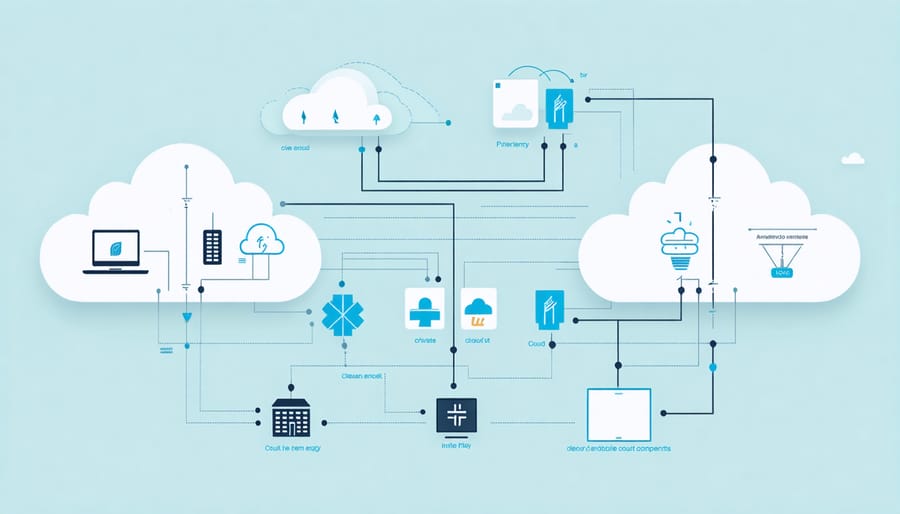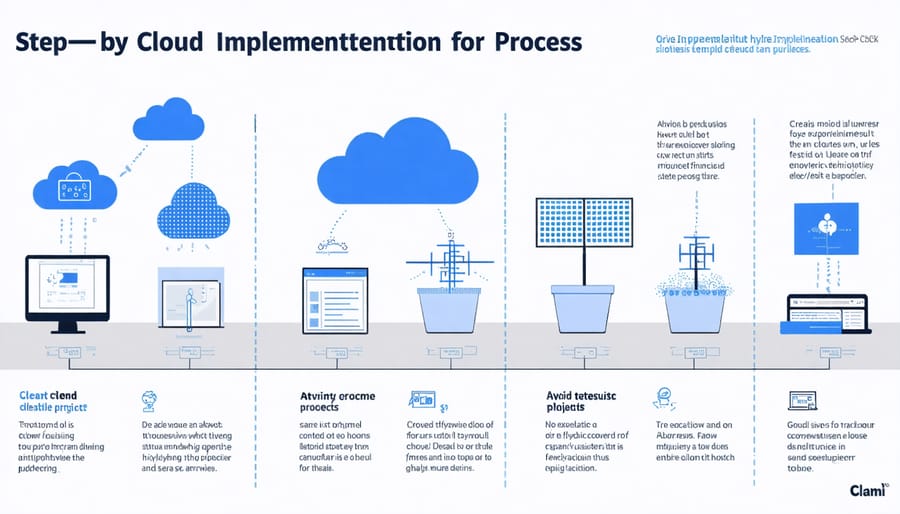In today’s dynamic technology landscape, hybrid cloud architecture emerges as a game-changing solution for organizations navigating the complex intersection of public and private infrastructure. By combining the scalability of public clouds with the security of private systems, hybrid solutions are transforming how Australian businesses approach their renewable energy initiatives and digital transformation strategies. This innovative approach allows organizations to maintain sensitive data on-premises while leveraging the cost-effectiveness and flexibility of public cloud services, creating a seamless, integrated computing environment that adapts to changing business needs. As sustainability becomes increasingly crucial, hybrid cloud solutions offer the perfect balance between operational efficiency and environmental responsibility, enabling businesses to scale their operations while minimizing their carbon footprint.
Understanding Public-Private Hybrid Clouds

Public Cloud Components
Public cloud components serve as the powerhouse behind many clean technology deployments, offering scalable and flexible resources that can be accessed from anywhere. These components typically include computing power, storage solutions, and networking capabilities provided by major cloud service providers. In the Australian context, these resources have been particularly valuable for solar and wind energy projects, enabling real-time monitoring and optimization of renewable energy systems.
The beauty of public cloud resources lies in their pay-as-you-go model, making advanced technology accessible to organisations of all sizes. For clean tech initiatives, this means access to sophisticated data analytics tools, artificial intelligence capabilities, and robust security features without the need for significant upfront investment. Companies can easily scale their operations during peak periods, such as during major renewable energy installations or when processing large volumes of environmental data.
Leading Australian renewable energy projects are increasingly leveraging these public cloud components to improve efficiency and reduce operational costs while maintaining their commitment to sustainability.
Private Cloud Infrastructure
Private cloud infrastructure offers organizations complete control over their computing resources while maintaining the flexibility of cloud technology. Like having your own dedicated data centre, it provides enhanced security and compliance capabilities, making it ideal for handling sensitive information and mission-critical workloads. Organizations can customize their infrastructure to meet specific requirements, from implementing strict access controls to optimizing performance for particular applications.
The private cloud environment typically operates behind a corporate firewall, ensuring data sovereignty and addressing compliance requirements crucial for industries like healthcare and finance. This setup allows businesses to maintain better oversight of their resources while still benefiting from cloud features such as scalability and resource pooling.
For environmentally conscious organizations, private clouds can be configured to maximize energy efficiency through optimized resource allocation and green data centre practices, contributing to sustainable operations without compromising on performance or security.
The Hybrid Advantage
The combination of public and private cloud infrastructure creates a powerful synergy for renewable energy projects. This hybrid approach allows organizations to maintain sensitive operational data on private servers while leveraging the scalability of public clouds for peak demand periods. For example, Australian solar farms can keep critical control systems secure in private clouds while using public infrastructure to process vast amounts of weather prediction data and consumer usage patterns.
This flexible model proves particularly valuable during renewable energy project development, where computational needs fluctuate significantly. During construction phases, teams can quickly scale up public cloud resources for complex modeling and design work, while maintaining confidential project documentation in private infrastructure. The hybrid setup also enables real-time data sharing between field operations and central management, ensuring seamless coordination while maintaining robust security protocols.
By combining both cloud types, organizations can optimize costs while maintaining the highest levels of data protection and operational efficiency.
Real-World Applications in Clean Tech
Smart Grid Management
In Australia’s evolving energy landscape, hybrid cloud solutions are revolutionizing how we manage and distribute renewable energy. Through advanced smart grid management systems, power utilities can seamlessly integrate various renewable sources while maintaining grid stability and reliability.
The hybrid cloud approach combines the best of both worlds – the security of private clouds for sensitive operational data and the scalability of public clouds for peak demand management. This integration enables real-time monitoring of energy consumption patterns, automated load balancing, and predictive maintenance of grid infrastructure.
For instance, when solar farms in Queensland experience sudden production spikes on particularly sunny days, hybrid cloud systems can instantly adjust distribution patterns and storage solutions across the network. This flexibility ensures that excess energy isn’t wasted and can be efficiently redirected to areas of high demand.
The system’s ability to process vast amounts of data locally while leveraging cloud-based analytics has proven particularly valuable during extreme weather events. During the 2022 flood season, several Queensland utilities successfully maintained grid stability by using hybrid cloud solutions to quickly adapt to changing conditions and reroute power supplies.
This technological advancement is helping Australia transition towards a more sustainable energy future, with some regions already achieving up to 60% renewable energy integration into their existing grid infrastructure.

Bioenergy Project Integration
In the heart of Queensland’s sugarcane region, the Mackay Renewable Bioenergy Facility showcases how hybrid cloud solutions revolutionize bioenergy production. The facility leverages a sophisticated hybrid cloud infrastructure to monitor and optimize its bagasse-to-energy conversion process, seamlessly integrating private on-premises systems with public cloud capabilities.
The facility’s control room operators use real-time data processing through their private cloud to manage critical operations, while less sensitive data is processed and analyzed in the public cloud. This dual approach enables them to maintain strict security protocols while benefiting from the scalability of cloud computing.
Another stellar example is the Western Australian Biogas Plant, which implements a hybrid cloud solution to coordinate its waste-to-energy operations. The plant’s management system uses private cloud infrastructure for sensitive operational data while utilizing public cloud services for community engagement and renewable energy certificate trading.
These facilities demonstrate how hybrid cloud architecture supports the growing bioenergy sector. Key benefits include enhanced operational efficiency, reduced downtime through predictive maintenance, and improved resource allocation. The hybrid approach also enables these facilities to scale their computing resources during peak production periods without compromising security.
Smart meters and IoT sensors throughout these facilities feed data into the hybrid cloud system, creating a comprehensive view of operations while maintaining data sovereignty – a crucial consideration for Australian energy infrastructure.
Implementation Strategies for Australian Projects

Planning and Assessment
When evaluating hybrid cloud solutions for clean technology projects, a systematic approach ensures optimal outcomes. Start by conducting a thorough assessment of your current infrastructure and identifying specific requirements for data storage, processing power, and security needs. Consider factors like peak usage periods during renewable energy generation and the volume of environmental monitoring data.
Create a detailed inventory of existing applications and determine which workloads are best suited for public cloud environments versus those that need to remain on-premise. For example, real-time solar panel monitoring systems might benefit from public cloud scalability, while sensitive grid management data could stay in private infrastructure.
Develop clear metrics for success, including sustainability targets, cost efficiency goals, and performance benchmarks. Australian organisations should particularly consider data sovereignty requirements and local renewable energy regulations when planning their hybrid cloud architecture.
Establish a timeline for implementation that accounts for testing phases and gradual migration of systems. This might involve starting with non-critical applications before moving to core operational systems. Consider engaging cloud service providers with strong environmental credentials and experience in the clean technology sector.
Remember to plan for future scalability as your clean tech projects grow. Regular reviews of your hybrid cloud strategy ensure it continues to meet both technological and sustainability objectives while maintaining optimal performance and cost-effectiveness.
Integration Best Practices
Successful integration of public, private, and hybrid cloud solutions requires a thoughtful, strategic approach that prioritizes sustainability and operational efficiency. Organizations should begin by conducting a thorough assessment of their current infrastructure and identifying which workloads are best suited for each cloud environment, particularly when dealing with clean technology implementation projects.
Start with establishing clear governance policies that outline data management, security protocols, and compliance requirements across all cloud environments. This framework should be flexible enough to accommodate future scaling while maintaining robust security measures.
Implement standardized processes for workload migration and management, ensuring seamless communication between different cloud platforms. Consider using cloud management platforms (CMPs) that provide unified visibility and control across your entire cloud infrastructure.
Focus on creating a skilled team that understands both traditional IT operations and modern cloud technologies. Regular training and upskilling programs are essential for maintaining operational excellence.
Don’t forget to establish comprehensive monitoring systems that track performance, costs, and resource utilization across all environments. This helps optimize resource allocation and identify potential issues before they impact operations.
Finally, develop a clear disaster recovery plan that accounts for all cloud environments, ensuring business continuity regardless of where your data and applications reside. Regular testing and updates of these procedures will help maintain system reliability and performance.
As we look to the future of clean technology adoption in Australia, hybrid cloud solutions stand as a crucial enabler of sustainable innovation. By combining the best of public and private cloud infrastructure, organizations can create more resilient, scalable, and efficient systems for managing renewable energy projects and environmental initiatives.
The flexibility of hybrid cloud architectures has proven instrumental in accelerating the deployment of smart grid technologies, solar farm management systems, and wind energy monitoring platforms across the country. From the bustling renewable energy hubs of South Australia to the emerging clean tech startups in Queensland, we’re seeing how this technology enables both established players and newcomers to innovate while maintaining security and cost-effectiveness.
Looking ahead, hybrid cloud solutions will play an even more vital role in Australia’s clean energy transition. As our nation continues to set ambitious renewable energy targets, the ability to seamlessly scale operations, process vast amounts of environmental data, and coordinate distributed energy resources becomes increasingly important. The hybrid approach offers the perfect balance, allowing organizations to maintain sensitive data on-premises while leveraging the power of public cloud services for broader applications.
The success stories we’re seeing today are just the beginning. With continued advancement in cloud technologies and growing expertise in implementation, we can expect to see more innovative applications emerging. Whether it’s improving energy efficiency in our cities, optimizing renewable resource management, or enabling new sustainable business models, hybrid cloud solutions are helping pave the way toward a cleaner, more sustainable future for Australia.
For organizations considering the transition to clean technology, the hybrid cloud model offers a practical, flexible foundation that can grow and adapt alongside their sustainability journey.

